Long-legged cats have a unique aesthetic appeal. These exotic felines have elongated metatarsal bones in their feet, making their legs grow longer compared to their body size. Although most cat breeds with long legs look like wild felines, their endearing personalities make them excellent furry companions.
The most common cat breeds with long legs include the Savannah, Abyssinian, Chausie, and Oriental Shorthair cats. These cat breeds have striking visuals and unique personalities ranging from calm to dog-like traits. However, although they differ in care requirements, most are average or low-maintenance pets.
Keep reading to learn about the top 10 cat breeds with long legs. We will unveil their unique personalities and care needs to make it easier for you to decide which breed is a perfect match for your household.
Let’s get started!
1. Savannah Cat

- Height —14 to 17 inches (35.56 to 43.18 cm)
- Weight—12 to 25 pounds (5.44 to 11.34 kg)
- Lifespan—12 to 20 years
Tall and elegant, the Savannah cats are a sight to behold. They are a hybrid from crossing the wild serval and Siamese cat and were first developed in the late 20th century. The Savannah’s most outstanding features include its long legs, large perked ears, and spotted coat.
The first-generation crosses of the Savannah cats are generally larger than later generations. They can reach up to 17 inches (43.18 cm) tall and weigh 25 pounds (11.34 kg) because of their close bloodline with their wild ancestor. Also, they have longer, more powerful legs and can leap up to 8 feet (2.44 meters) high from a standing position.
Find Out: Why Do Cats Run After Pooping? 5 Causes and Their Solutions
Personality
Savannah cats have a friendly and playful demeanor. Although they look wild, most are docile and enjoy spending time indoors or with their human family members. These cats are loyal, intelligent, and curious, especially during kittenhood.
Savannah cats make excellent family pets, although they may not be suitable for first-time cat owners. This is more so if you want a first-generation breed that may still have a few traits of its wild serval parent.
Also, some states restrict ownership of Savannah cats as pets. Therefore, you must check your state ordinances before adopting the breed.
The states that have banned ownership of Savannah cats include.
- Georgia
- Hawaii
- Nebraska
- Rhode Island
Care Needs
Savannah cats are intelligent and full of energy. As active cats, they have above-average physical and mental stimulation needs and are happier living in homes where they can hide, climb, and run all day. Just remember to keep breakable objects away to avoid possible accidents.
Keeping your cat looking great is not a hassle because Savannah cats have short coats that require minimal care. Brush your cat’s coat occasionally to remove dead skin and loose hair, and trim its nails monthly.
Moreover, it helps to get your pet accustomed to teeth brushing to make it easier to maintain a healthy dental.
2. Abyssinian Cat
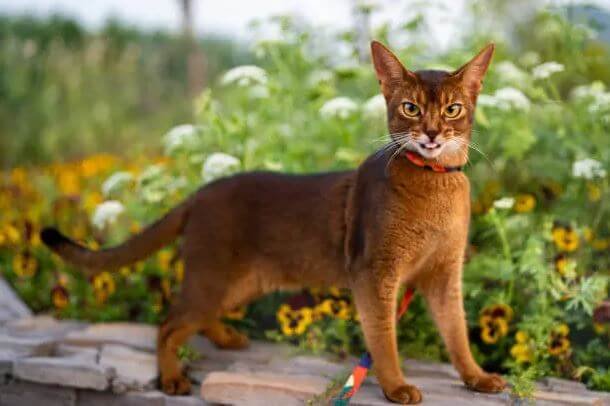
- Height—8 to 10 inches (20.32 to 25.4 cm)
- Weight—8 to 12 pounds (3.63 to 5.44 kg)
- Lifespan—9 to 13 years
The Abyssinian cat has a slender, athletic body that gives it a sleek and graceful look. Unlike the Savannah, which features a spotted coat, this breed has a distinctive ticked coat that gives it an equally striking visual appeal. It is one of the oldest feline breeds and among the most popular worldwide.
Fondly called “Aby,” the Abyssinian cat has numerous enchanting features. Besides the relatively long legs, it has large, erect, well-cupped ears. It’s also hard not to notice the wedge-shaped head and large, alert almond eyes.
Also Read: What Happens to Bonded Cats When One Dies? 6 Ways to Help Your Cat
Personality
Abyssinian cats have warm personalities that make excellent furry companions for any home. However, you should know that this is not your regular laid-back cat breed. Abyssinian cats are active, and many consider them to have a dog-like desire to socialize and spend time with family members.
Moreover, Abys are intelligent and curious. Although best kept indoors, they have unquenchable wanderlust and must be monitored when playing outdoors.
Care Needs
Abyssinian cats have short, dense coats that don’t shed much outside the regular shedding seasons. Although not hypoallergenic, they only need occasional coat brushing and nail trimming.
Generally, Abys are low-maintenance cats. However, they have an above-average need for mental and physical stimulation, just like Savannah cats. They are known to love spirited play sessions and love nothing more than to spend hours jumping, running, leaping, climbing, and exploring their environments.
3. Chausie
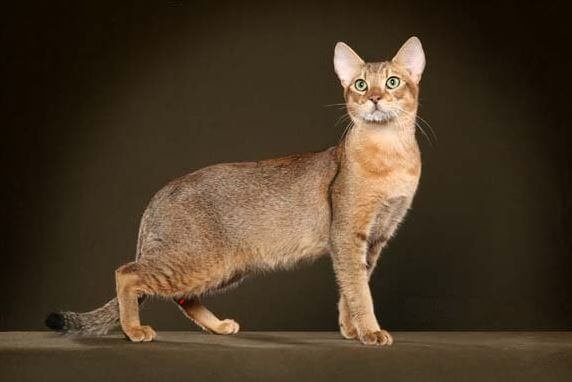
- Height— 20 to 22 inches (50.8 to 55.88 cm)
- Weight— 15 to 25 pounds (6.8 to 11.34 kg)
- Lifespan— 10 to 15 years
The Chausie is an Egyptian cat breed believed to have occurred naturally from mating wild cats with domestic cats.
Chausies are lean, athletic and have deep chests, pointed ears, and jutting cheekbones. Moreover, these cats often have grizzled or ticked coats resembling their jungle-dwelling ancestors. You can also find Chausies with more solid-hued coats and only light remnants of the grizzling or ticked pattern.
Personality
Don’t let Chausie’s wild looks deceive you. These cats are friendly, affectionate, and playful. They love human company and may even be ill-fit for people who spend most of their time away from their homes.
Moreover, Chausies are social and don’t mind having fellow feline or canine housemates. They also tolerate children and can fit well in families with small kids. If you have always wanted an intelligent cat, this is one of the top breeds you should consider.
Care Needs
The Chausies have short coats that shed moderately. Brushing their coats once or twice weekly helps to reduce the hairs shed in your living spaces. Generally, this breed is not hypoallergenic and can cause allergies to people sensitive to cat fur or dander.
Moreover, the breed has more than the standard exercise needs of other domestic cats. Chausies are happier when they spend most of their time moving and jumping. Thanks to their intelligence, they are trainable, and you could leash-train your cat and take it for walks around the hood.
4. Oriental Shorthair cats
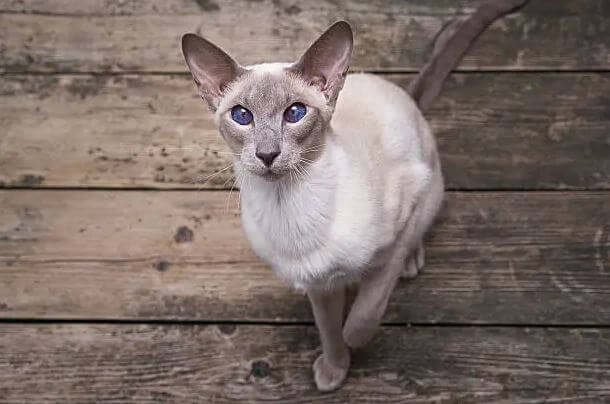
- Height—9 to 11 inches (22.86 to 27.94 cm)
- Weight—8 to 12 pounds (20.32 to 30.48 cm)
- Lifespan—12 to 15 years
Oriental shorthair cats have long, slender frames. Although they are medium-sized cats, their svelte figures and long legs often exaggerate their overall size.
One of the most distinct features of the Oriental Shorthair cat is its coat. The breed has a smooth, silky coat that lies close to the body and comes in up to 300 color variations. Other hard-to-miss features include the cat’s angular face, big eyes, and wide-set ears.
Personality
The Oriental Shorthair cats make excellent pets for more than their good looks. These cats are athletic, intelligent, affectionate, and quite social. They are considered “Velcro cats” because they love following their owners from room to room and cuddling beside them all day.
Moreover, Oriental Shorthair cats are a vocal breed that can persistently meow when they crave human interaction or need your attention. Generally, these cats are always in the mood for a chat and tend to be talkative even when content.
Care Needs
Oriental shorthair cats have easy-to-care-for coats. Weekly brushing and occasional baths can help keep them looking their best. Also, you’ll need to pay extra attention to their big ears and wipe them down occasionally with a wet cotton ball.
Health-wise, Oriental Shorthair cats are no trouble. They are a hardy breed, although you must keep up with regular vet checks to ensure your kitty stays happy and healthy. Another tip to enhance your pet’s health is to provide plenty of mental and physical stimulation to keep boredom at bay.
5. Bengal Cat
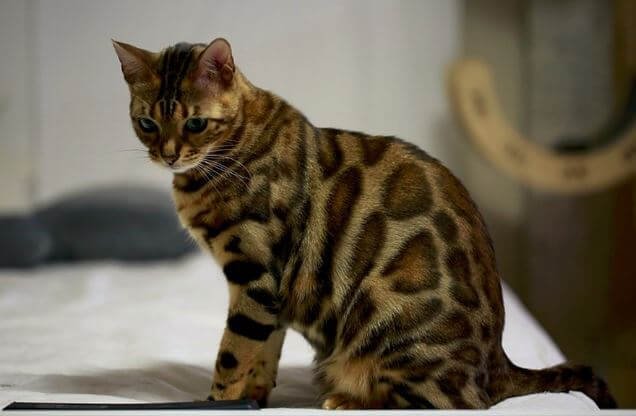
- Height—8 to 10 inches (20.32 to 25.4 cm)
- Weight—8 to 15 pounds (3.63 to 6.8 kg)
- Lifespan—9 to 15 years
Bengals are gorgeous cats with boldly patterned coats. They have regal aesthetics and boast long bodies, long tails, and equally long legs. At a close glance, you’ll notice that their hind legs are slightly longer than their front legs.
A unique aspect that sets Bengal cats apart from other felines is that they are the only breed that can have rosette coat markings. These cats have marbled or spotted coats that they get from their wild Asian leopard heritage.
Find Out: Why Is My Kitten So Hungry All the Time? 5 Reasons and What to Do
Personality
Bengal cats may look wild outside but are sweet and soft inside. These cats are affectionate and love spending time with kids, adults, or other resident pets. Moreover, they are intelligent and curious and can benefit from outdoor adventures when on a leash.
If you have always wanted a chatty cat, it’s hard to go wrong with the Bengal. Your cat will let out a meow when it wants something and even vocalize to acknowledge your presence once you get home from work.
Care Needs
Bengal cats have dense, short coats that don’t shed much outside the regular shedding seasons. Still, it is vital to brush them weekly to remove loose hair and dead skin cells. While at it, remember to wipe down the ears and trim the claws if you hear them tapping the floor as your pet walks.
As a lithe and agile breed, Bengal cats need regular play sessions. They are smart cats, and it is important to stimulate their minds with interactive cat toys. Moreover, entertainment resources like a cat tree can help encourage your furry friend to climb and jump to its heart’s content.
6. Arabian Mau
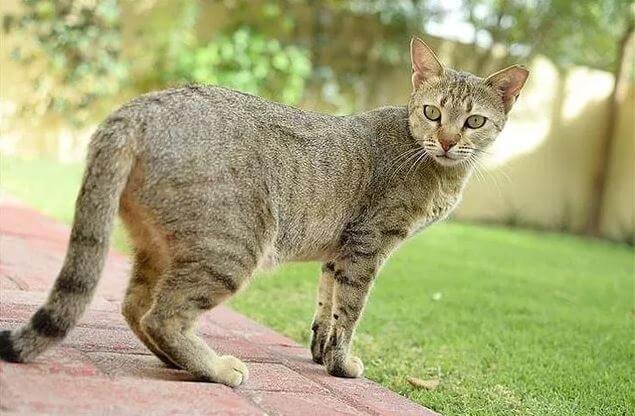
- Height—8 to 10 inches (20.32 to 25.4 cm)
- Weight—9 to 16 pounds (4.08 to 7.26 kg)
- Lifespan—12 to 17 years
The Arabian Mau is a natural feline breed. It is believed to be a descendant of the desert cat that for centuries roamed in the desert of the Arabian Peninsula.
All the features of the Arabian Mau, apart from the striking green eyes, help it adapt to the extreme Arabian climate. Some of the outstanding features of the breed include a sleek build, long legs, and large, pointed ears that help release heat.
Personality
Arabian Mau cats are affectionate, friendly, and devoted to their owners. They are warm cats that get along well with kids and other pets. Still, you must beware of their independent streak.
Although friendly, Arabian Mau cats are not lap pets. Your furry friend will enjoy your company and even follow you around, but don’t expect it to snuggle up with you on the sofa.
Care Needs
You should consider adopting an Arabian Mau if you want a low-maintenance feline breed. Again, these cats have an independent streak and are good at grooming themselves. They also hate baths but will, fortunately, keep themselves super neat.
As an active feline breed, satisfying your pet’s need to run, jump, climb, and explore is important. A cat tree can do the trick, and it would also help to invest in plenty of interactive toys to keep your pet’s body and mind engaged.
7. Egyptian Mau
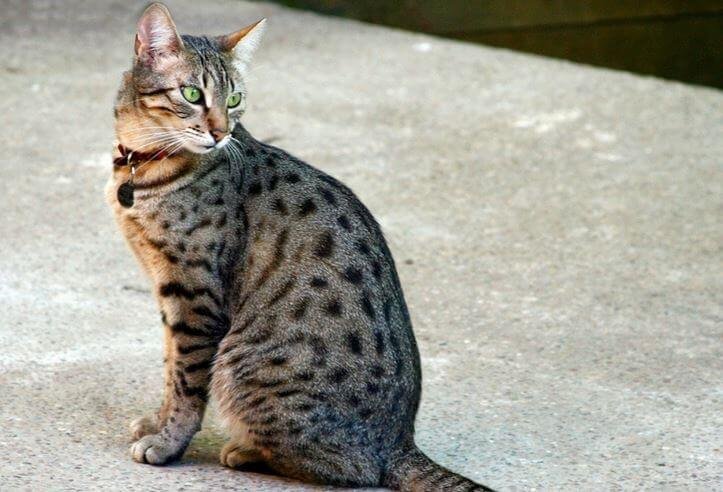
- Height—7 to 11 inches (17.78 to 27.94 cm)
- Weight—8 to 12 pounds (3.63 to 5.44 kg)
- Lifespan—9 to 13 years
The Egyptian Mau has a rich history that dates back over 3,000 years. It has a lean build and long limbs that give it outstanding regal aesthetics and a true athlete’s appearance. What’s more, the Egyptian Mau cats are a naturally occurring breed with elegantly spotted coats.
Mau coats come in various colors: black, caramel, blue/pewter, smoke, silver, and bronze. You’ll also notice a tabby pattern and dark dorsal stripe that runs from the head to the tip of the tail. Other features include a slightly oblong head, bright green almond-shaped eyes, and pointed ears set somewhat wide apart.
Personality
Egyptian Mau cats are intelligent, affectionate, and loyal to their owners. Although friendly with family members, these cats are almost always standoffish with strangers. They are shy fellows who often run and hide when a stranger approaches.
When well-socialized, Egyptian Mau cats warm up quickly to friendly faces. They also interact well with kids and other felines. They make excellent family pets because of their playfulness and enchanting sense of humor.
Care Needs
Egyptian Mau cats are moderate shedders. However, they are fastidious groomers and only need a good coat brushing once or twice weekly. You can take advantage of your grooming sessions to make them serve as your special bonding time.
To keep your furry friend happy and healthy, ensure you keep up with regular vet checks. Also, be sure to brush your pet’s teeth, wipe down the ears, and do nail trims regularly.
8. Turkish Van
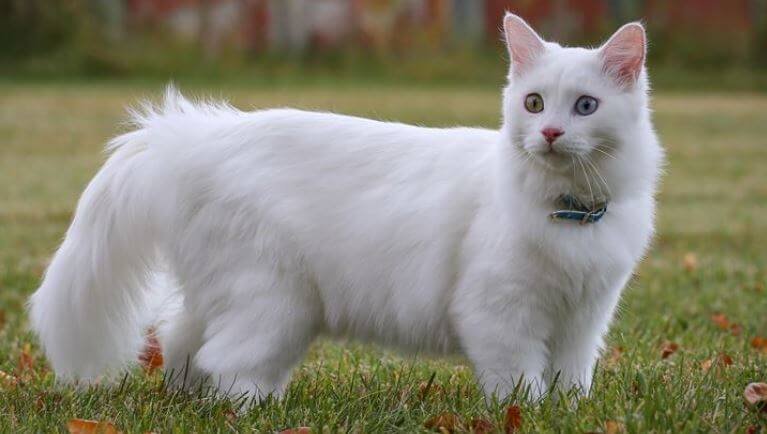
- Height—10 to 14 inches (25.4 to 35.56 cm)
- Weight— 10 to 20 pounds (4.54 to 9.07 kg)
- Lifespan—12 to 17 years
Turkish Vans have an interesting history. Although the breed’s origin is murky, Turkish folklore suggests these cats sailed aboard Noah’s ark!
Looks-wise, Turkish Vans feature the “Van pattern.” This is when a feline only has color on its head and tail. The rest of the body has a solid white hue, although some cats also have a patch of color between their shoulder blades.
Personality
Turkish Van cats are curious, playful, and intelligent. Most importantly, they are warm, loving, and affectionate pets who love following their owners from room to room. Although not lap cats, they can suffer separation anxiety if left alone for too long.
Unlike most cats, Turkish vans love water. They are fondly called the “swimming cats” and love to spend time around ponds, swimming pools, and other water bodies. Generally, you cannot trust them around your fish pets.
Care Needs
Besides the usual grooming routines, Turkish Vans are large cats that require nutrient-packed foods to fuel their active lifestyles. Ensure the kibble you choose and the portions you serve are age-appropriate to reduce the risk of your kitty getting under or overweight.
As athletic felines, Turkish Van cats love to jump, climb, and explore. Although they can occasionally curl up next to their owners for a short cuddling session, they are happier when offered plenty of opportunities to play and search for adventure.
9. Turkish Angora
- Height —9 to 14 inches (22.86 to 35.56 cm)
- Weight—8 to 15 pounds (3.63 to 6.8 kg)
- Lifespan—9 to 14 years
The Turkish Angora is a visual magnet best known for its gorgeous long fur that comes in various colors and patterns. Its intelligence and aesthetics earned it the position of a national treasure in its native country, Turkey.
Angoras are medium-sized cats with slender and delicate aesthetics. They feature extra-long limbs that make many perceive them as large cats. Other outstanding features include their relatively small and round heads, wide ears, and large, almond-shaped eyes that come in blue, green, amber, or blue-green.
Personality
Turkish Angoras have a regal disposition. They carry themselves with grace and dignity and will often not let their guard down until they develop a strong bond with you. Once they mark you as family, they don’t shy away from showing you their social and affectionate side.
Most Turkish Angoras are highly vocal and tend to meow louder than other feline breeds. Although they can hear, deafness is a trait that runs in their bloodline, and most cats of the breed cannot modulate the volume of their voices. Fortunately, even completely deaf Angoras enjoy a good quality of life and live for 9 to 14 years with proper care.
Care Needs
Turkish Angora cats have long, smooth, and gorgeous coats. Although they only shed moderately, you should brush their coats once or twice weekly to keep them looking their best. Start your grooming routines at a young age to get your kitty acclimated and comfortable with coat maintenance, nail trimming, and teeth brushing routines.
Also, provide plenty of resources to keep your cat active and entertained throughout the day. Angoras have an independent streak and can play alone, although it is best to interact with them during play sessions. These cats don’t get enough spirited playtime with their owners.
10. Serengeti
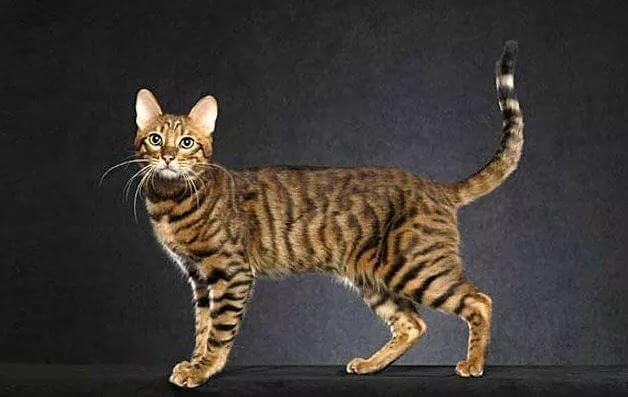
- Height—8 to 10 inches (20.32 to 25.4 cm)
- Weight—8 to 15 pounds (3.63 to 6.8 kg)
- Lifespan—10 to 15 years
The Serengetis look like wild cats but are 100% domesticated. They are a relatively new breed developed around the 1990s by crossing the Bengal and Oriental Shorthair cats. Like both parent breeds, Serengeti cats have long limbs and a regal demeanor.
Other features that give these cats a unique cute factor are their coats, which have bold and widely spread spots. These felines also have slightly slanted eyes and big round ears, giving them a distinctly exotic look.
Personality
The Serengeti cats are lap cats and will cuddle with their owners whenever possible. These cats are affectionate, friendly, and easygoing, which makes them ideal for families with kids and other pets.
Furthermore, you can expect your cat to always be up for a chat. Although Serengeti cats also have an independent streak, they can crave the attention of their owners if left alone for too long.
Care Needs
Thanks to the genetic diversity caused by crossbreeding, Serengeti cats are relatively healthy. Still, it is vital to schedule regular vet checks to ensure your pet remains happy and healthy.
In terms of grooming requirements, these cats are low maintenance because their coats don’t shed much. You only need to brush their coats occasionally and give their claws a nice trim. Don’t forget to check the ears and wipe them down during your grooming sessions.
Final Thoughts
There you have it—the 10 cat breeds with long legs. The felines on our list are magnificent creatures of beauty, and adults stand between 9 and 22 inches (22.86 to 55.88 cm) tall.
They reach their full height in twelve months but continue growing for another year as they gain weight and muscle.
Long-legged cats are just as endearing as their regular counterparts. The only thing that sets them apart is their long legs and ability to jump and sprint at remarkably high speeds!

